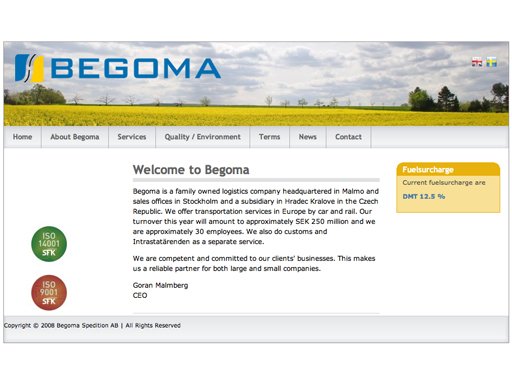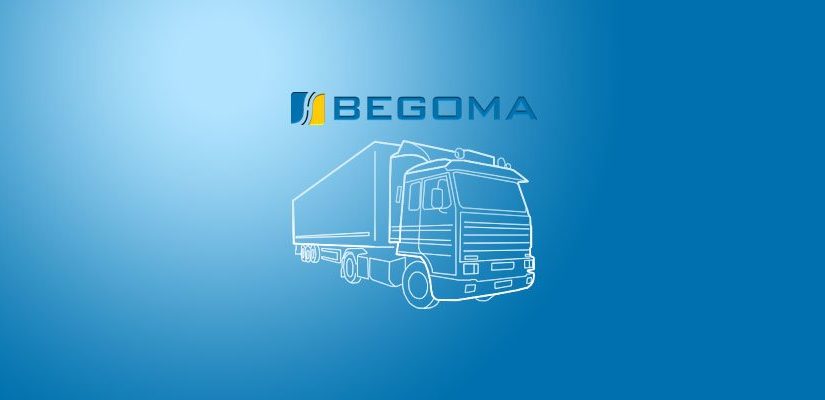Begoma is a family-owned logistics company headquartered in Malmö, Sweden, with sales offices in Stockholm and a subsidiary in Hradec Králové, Czech Republic. Specializing in transportation across Europe by road and rail, Begoma is known for its efficient and reliable services. In addition to transport, Begoma also offers customs clearance and Intrastat reporting as standalone services.
To keep pace with growing operational demands, Begoma approached Diatom Enterprises with a clear objective: modernize their aging client application. The existing system, built in Microsoft Access. excel and multiple 3rd side apps during the late 1990s and 2000s, had become insufficient for the company’s evolving needs. They required a more robust, scalable solution that could streamline their logistics operations — from managing complex orders and traffic planning to automating invoicing and dynamic price calculation.

Project size: 5-15 Software developers, Architects, QA, Automate QA and UI-UX designers
Solution: Multiple crossplatform systems, ERP, Public Web platforms, API integrations and mobile apps.
Duration: since March 2011 up till now
Our Solution
Diatom was tasked with designing and developing a new system from the ground up — one that would not only replace the legacy software but also support advanced features such as XML data integration, online order processing, real-time reporting, and comprehensive traffic management tools.
The result was a powerful desktop application for internal use by Begoma’s staff and subsidiaries. Additionally, we developed a web client that allows Begoma’s customers to place orders online and track their shipment status, enhancing both user experience and operational transparency.
At the heart of the system lies an intelligent traffic and load management module, which significantly improves route efficiency, resource planning, and cost optimization.
The Name Behind the System
Every great product deserves a name with meaning. Inspired by a personal connection — the wife of a close friend of Begoma’s CEO, Goran Malmberg, who happened to be from Riga — the system was named Irena. This thoughtful gesture resonated with our team at Diatom, as our headquarters are proudly located in Riga, Latvia.
Project Journey with Begoma: From Requirements to Real Results
The collaboration between Diatom Enterprises and Begoma officially began in March 2011, marking the start of a transformative project aimed at modernizing Begoma’s logistics software infrastructure.
Laying the Groundwork
The initial phase focused on discovery and alignment. Our team worked closely with Begoma’s stakeholders to elicit detailed requirements, define a robust solution architecture, and craft a strategic development roadmap.
Recognizing the dynamic nature of the logistics industry — and the likelihood of evolving requirements — both teams agreed to adopt an Agile development methodology. This gave us the flexibility to respond to change without losing momentum.
As planning began, we evaluated established design patterns and proven third-party component frameworks to ensure efficiency and reliability. We made a conscious decision to avoid reinventing the wheel, allowing our developers to focus on delivering real business value rather than spending time on repetitive or low-impact technical challenges.
Beyond Coding: Strategic Partnership
Throughout the development lifecycle, our team contributed more than just code. We provided strategic recommendations that helped shape the product’s functionality and long-term performance. This proactive approach gave Begoma confidence that Diatom wasn’t just a vendor — we were a dedicated partner, taking ownership of the solution’s success.
As our professional relationship deepened, it naturally evolved into a lasting friendship. We often say we wish all our clients were like Begoma — collaborative, insightful, and trusting.
Tackling Challenges Head-On
No real-world software project is without its obstacles — and this one was no exception.
One of the primary challenges we faced was related to application performance. The project leveraged a third-party UI component framework, which — during testing — revealed critical memory leaks. Each time a new form was opened, memory usage surged significantly, straining system resources.
We immediately escalated the issue to the component vendor, who acknowledged the problem and released a patch. However, the new version introduced backward compatibility issues — some form controls no longer functioned as expected. This required extra development time to refactor and retest affected modules.
Thanks to open communication and trust, Begoma was kept fully informed throughout the process. They knew Diatom would see the issue through — and we did. Within a few weeks, the patched version was deployed to the production environment. The results were clear: the application’s performance had improved dramatically, running smoother and more efficiently than ever before.
Results: Delivering Value, Driving Efficiency
The first version of the Irena application was successfully launched in early September 2011, right on schedule. The response from end users was overwhelmingly positive. Users immediately appreciated how much of their day-to-day routine had been streamlined, with many previously manual tasks now fully automated — significantly reducing the risk of human error and saving valuable time.
Following a two-year development journey, the final product proved to be a powerful, reliable system that became an integral part of Begoma’s daily operations, used consistently by over 30 staff members across multiple offices. The implementation brought measurable improvements:
-
Manual scheduling and load planning overhead was dramatically reduced
-
Operational efficiency increased, enabling a higher volume of transactions to be processed smoothly every day
The success of the Irena system didn’t mark the end — it marked a new beginning. Impressed by the results and the dedication of the Diatom development team, Begoma extended the partnership. We continue to work closely together, actively expanding the system’s capabilities with new features that further enhance performance, usability, and business value.
